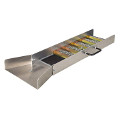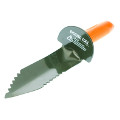Published on
South Carolina doesn't have the rich gold history that some other states have, but it's still a good place to prospect. Here we review the state's gold history, its gold mines, and the current best spots for panning.
History
Gold was first discovered in South Carolina in 1802. The discovery was made in Greenville County. In the following years, additional discoveries were made across the state, inspiring several commercial mining projects. By the turn of the century, South Carolina's gold was heavily depleted. Commercial mines and individual prospectors alike began to struggle. Most commercial mining operations eventually moved out of the state, but individual prospectors remained. Most of the state's remaining gold is fine placer. Because of its small size, it can be difficult to extract with just a pan. A sluice box is a better option.
Gold Mines in South Carolina
South Carolina had several successful gold mines, and one of them is still running today. Learn about these mines below.
Haile Gold Mine
The Haile Gold Mine was first discovered in 1827 by Benjamin Haile. It quickly became one of the most profitable gold mines in South Carolina. Mining continues in the Haile Gold Mine today and is presided over by the OceanaGold company.
Barite Hill Gold Mine
Located in McCormick County, the Barite Hill Gold Mine produced 58,996 ounces of gold between 1990 and 1994. During the same period, 109,000 ounces of silver were extracted from the mine. Despite its productivity, activity in the Barite Hill Gold Mine ceased shortly after its peak years.
Ridgeway Gold Mine
In 1988, the Ridgeway Gold Mine opened in Fairfield County. It operated for just 11 years. During this time, around 1.5 million ounces of gold and 900,000 ounces of silver were extracted from the mine.
Best Prospecting Tools
| Product | ||
|---|---|---|
| Gold Pan |  |
|
| Sluice Box |  |
|
| Small Digging Tool |  |
|
| Glass Vials |  |
Best Panning Spots
There are a number of rivers in South Carolina where hobbyists can pan for gold. The laws and regulations for panning are relaxed. Generally you will only need a permit if you want to pan on National Forest land. In the section below, we'll examine some of the richest counties in the state.
York County

York County boasts a variety of gold-bearing streams for hobbyist panners to try their luck in. The most profitable of these streams is the Broad River. This river is a tributary of the Congaree River and it runs for 150 miles through North Carolina and South Carolina. It's panned by prospectors in both states. The York County stretch of the Broad River is one of its most productive.
York County prospectors should also try panning King's Creek, Wolf Creek, and Bullock's Creek. It should also be noted that nuggets have been reported in Rock Hill, although not with any great frequency.
Cherokee County
Cherokee County is perhaps best-known as one of the primary focuses of the controversial Nuclear Power 2010 Program. But among prospectors, it's recognized as one of South Carolina's most reliable producers of gold. It's home to Love Springs Mine, among other notable prospecting spots.
Love Springs Mine is located in the Appalachian Highlands. During its time in operation, it produced significant quantities of placer gold and it greatly contributed to the area's economy. Although Love Springs Mine is no longer active, Cherokee County boasts ample opportunities for recreational prospectors. Virtually all rivers and streams in the county are said to contain small quantities of lode gold. Some even contain gold that worked its way down from Love Springs Mine.
Saluda County
Gold can be found in almost all of the rivers in Saluda County. But of course some of its rivers are richer than others.
Saluda County prospectors have experienced the most success along the Little Saluda River. Gold that goes undiscovered in the Little Saluda River often works its way down to its tributaries.
Chesterfield County
Chesterfield County is home to only a few reliable producers of gold. The most notable is Nugget Creek. Aptly named, Nugget Creek has produced large pieces of gold in the past. But most prospectors now only manage to extract placer gold from Nugget Creek. With the right combination of skill and luck, you may capture one of the nuggets that gave the creek its name.
Conclusion
Those who lack experience could struggle to capture gold in South Carolina. It's best for newcomers to focus on states where gold is more plentiful and easier to find. The neighboring state of Georgia is better for beginners. We recommend South Carolina to experienced prospectors. Those who have spent years honing their craft have a decent chance of success here. In addition, the unique challenge that gold prospecting in South Carolina presents allows veterans of the hobby to further develop their skills.
